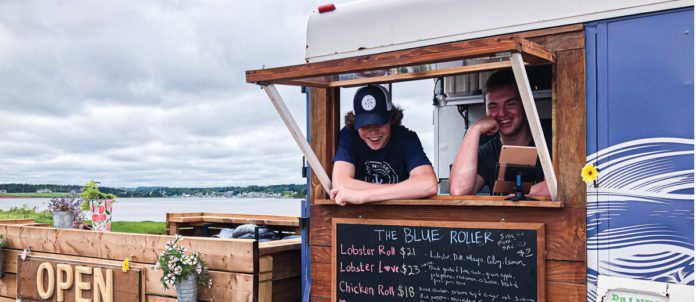
When COVID-19 struck and it was clear that her business would shift to takeout, Victoria Bazan, owner of Toronto’s Honest Weight, a combination fishmonger-seafood restaurant, was worried about how her food would travel. But, she says, “even now, when restrictions have lifted, people are still ordering takeout [items] that I would never have thought people would order.”
Across the country, it seems many COVID-forced survival strategies are going to stick around long after the pandemic has faded away, especially in the fish and seafood niche. Comfort food, already popular, has become a mainstay: doubly so if it’s handheld. Crystal MacGregor, director of Communications and Marketing for PEI’s Food Island Partnership, refers to “nostalgic, fond food memories with an elevated twist,” such as fish balls and crab cakes, while Bazan says “anything in between bread” is a winner, such as fish sandwiches and burgers.
The taste for zestier international flavours continues as well, says Jordan Sclare, executive chef for Toronto’s Chotto Matte, which focuses on Nikkei cuisine, a Peruvian-Japanese fusion (think sushi meets ceviche). The restaurant, with sister establishments in London and Miami, is owned by the NZR Group.
“Trendy culinary approaches seem to include savoury, bold flavors and more spices such as cardamom, ginger and pink peppercorn,” says Sclare. “Trendy seafood and fish include wild salmon, hamachi, mackerel, lobster handhelds and seafood boils. The Asian seafood trade in Canada is centered around large fresh Atlantic lobster, Alaskan King crab and Vancouver crab.”
World champion oyster shucker and restaurateur Patrick McMurray, formerly of Toronto’s Ceili Cottage, notes an undiminished proliferation of fish- and seafood-based restaurants such as chef Gordon Bailey’s FiN Take Away at Old Tracadie Harbour in P.E.I. and Drift, soon to open in Halifax under chef Anthony Walsh of Toronto’s Canoe. There’s the new upscale “sea-to-fork” restaurant Pink Sky in Toronto’s former Weslodge location, while Toronto’s Gerrard India Bazaar now hosts Puerto Bravo, a Mexican taqueria specializing in seafood. Hamilton, Ont.’s Shuck Truck, launched in 2019, continues to thrive with shrimp po’ boys and oyster takeout and delivery.
Steve Murphy of the Blue Mussel Café in North Rustico, P.E.I. added a converted trailer (the “Blue Roller”) to the back of his restaurant to sell handheld foods as takeaway. It helped maximize reduced dining-room seating, too, since some customers “get a lobster roll and go for a walk while waiting for indoor seating,” says Crystal MacGregor.
Grocery Revolution
In 2019, forward-looking operators were already blurring the line between retail and restaurant, either by selling their branded foods through chain grocers or by offering take-home packaged products to diners. During COVID-19, this trickle has become a landslide.
“You’re seeing massive creativity in the shape of dried, smoked, canned and frozen product,” says Ned Bell, chef and partner at Naramata Inn in B.C.’s Okanagan Region.
“We’ve always done really strong retail sales, but during COVID — wow!” says Bazan. “We’re selling cans of tinned seafood in the $30 and $50 range. It flew off the shelves.” High-end canned fish from Portugal and Spain are booming in many outlets, while its P.E.I.-based counterparts, Mary Manette Seafood and Scout, are also popular.
“In Spain or Portugal, it isn’t out of the ordinary to see elevated tinned seafood served in restaurants and bars. Now, we frequently see tinned fish stocked in restaurants and bars this side of the pond, too,” says chef Charlotte Langley, co-founder and chief culinary officer at Scout.
“When you open up the can, they’re lined up like these beautiful little angels,” Bazan says. Sustainable, shelf-stable and delicious, canned fish products make an elegant addition to warm potato salad or crostini, served either in the restaurant or at home.
“Another big trend that came out of 2020 was the rise of “seacuterie,” the seafood spin on classic charcuterie,” says Langley. In-house and in homes, diners are loving creative combinations of fresh, tinned, smoked, pickled and salt-cured fish and seafood on a rustic board.
Home Chefs Thrive
Like other suppliers, fishers were caught short by the transition from foodservice supply to home cooking, but Canada’s seafood industry negotiated the pivot with grace, partly aided by the fact that seafood was identified by consumers as their most “missed” food category during restaurant shutdowns, according to the Fisheries Council of Canada.
This yearning for fishy fare motivated home cooks to try more challenging dishes previously left to the professionals. “People were buying whole fish to grill at home, experimenting with different fish they’ve never cooked before,” says Bazan.
“Customers also turned to education — learning how to shuck [oysters] and purchasing make-at-home kits. That trend will not change,” says McMurray. Virtual cooking and wine-pairing classes were a hit, too, and many outlets — Rodney’s Oyster House and PearlDiver (Toronto), The Whalesbone (Ottawa), The Black Pearl (Edmonton) and others — “developed take-home boxes of fresh fish and shellfish and created events to ‘shellelebrate’ cooking at home,” he says.
Instagram is still very much the chef’s friend in this department, since home cooks delight in sharing their creations online.
Healthy Body, Healthy Planet
“We’re in the era of woke consumerism,” says Langley. Diners are demanding food that’s good for them and the planet. Seafoods are perceived as a wise food choice, even by some vegans, who are adding fish to their otherwise plant-based diets to embrace so-called “seaganism” and the extra nutrients that come with it.
Sclare says “87 per cent of consumers are most likely to buy seafood that’s described as fresh at restaurants, and half are willing to pay more for it. ‘Local.’ ‘wild-caught’ and ‘sustainable’ are also valuable seafood menu callouts, because these attributes tie back closely with transparent, eco-friendly practices and quality products. In fact, 75 per cent of seafood consumers are more likely to buy seafood that is locally sourced.”
“What is so interesting about seafood is that it ticks so may boxes when it comes to health, wellness and community sustainability,” says Bell. “It really is the perfect food.”
By Sarah B. Hood

















